#Petr Urban
Explore tagged Tumblr posts
Text
Kolektif – Dayanışmanın Zincirlerini Çözmek (2024)
Özgürlükçü düşünce tarihinin en etkili düşünürlerinden anarşist komünizmin kuramcısı Peter Kropotkin’in ‘Karşılıklı Yardımlaşma’ kitabı, dayanışma ve yardımlaşma ahlakının doğadaki ve insan öncesi türlerdeki kökenlerinin izini süren klasikleşmiş bir çalışmadır. Geliştirdiği noröplastisite kavramı üzerinden nörobilim alanına önemli katkılarda bulunan ve Derrida’nın öğrencisi olmuş çağdaş filozof…
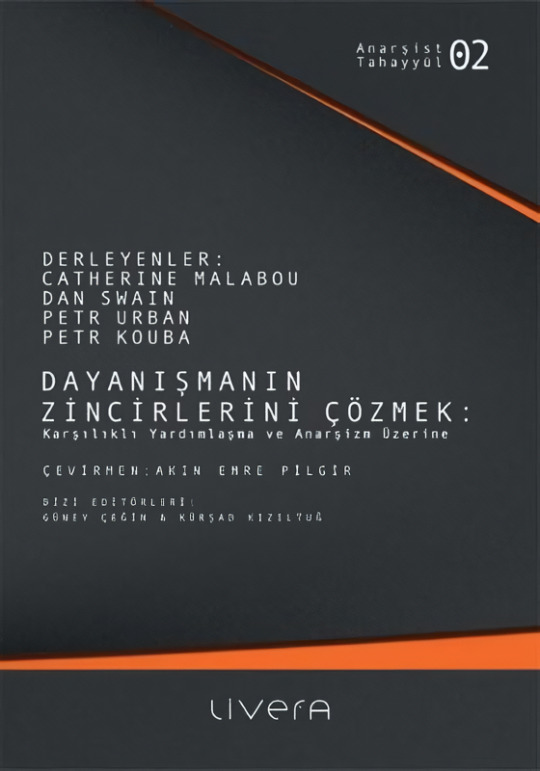
View On WordPress
#2024#Akın Emre Pilgir#Catherine Malabou#Dan Swain#Dayanışmanın Zincirlerini Çözmek#Karşılıklı Dayanışma ve Anarşizm Üzerine#Livera Yayınevi#Petr Kouba#Petr Urban
0 notes
Text

M. Laeta Francisco Petrarcae epistulam dedicat.
Fu nella tua città di Arezzo, maestro, ove per primo iniziai a dedicarmi alla lingua italiana.
Ero giovanissima, studentessa universitaria, americana, ignorante, peggio di tutto ero musicista, quando per prima sentii il tuo nome. (Petrarch, Petrarca, mi chiedevo, ma chi è questo? Petr-arca, arca di pietro, come un antico tempio romano. Recitavo il tuo nome come un incantesimo per placare il genius loci di Arretium, prima di leggere una tua singola parola. Perdonami.)
Ad Arezzo come in ogni altra città del mondo ero l’estranea di ogni gruppo sociale. La mia esperienza emblematica di questa vita da sempre è: osservare un circolo stretto di amici, dall’altra parte della stanza. Per quello studiavo piuttosto da sola, girovagavo in città da sola. Imparai un giorno che eri un poeta medioevale che cantavi d’amore, per una donna con cui non parlavi mai: come Dante con la sua Beatrice, sognando e piangendo ma sempre senza speranza, eri così per la tua Laura.
Alma del core, spirto dell’alma - sempre costante t’adorerò. Un altro ricordo di Arezzo di quell’estate. Una canzonetta settecentesca, una melodia tenera e semplice. Non c’entravi, eppur quando lo cantavo da sola nella mia voce tenua e fanciullesca, per le strade e nei parchi e boschetti, mi immaginavo di cantare per te, anche mentre cantavi a Laura. All’aria perfettamente vuota.
Una notte con i miei compagni di classe comprammo, con gli occhi sgranati e ridacchiando nervosi per il senso di trasgressione, una bottiglia di assenzio. Chiudemmo le luci a casa e facemmo il rito dello zucchero bruciato per addolcire il liquore amaro, lo bevemmo e ci sedemmo sul balcone della casa a guardare il cielo stellato e attendere le allucinazioni e visioni mistiche a noi promessi dalle leggende urbane e dagli scrittori morti male dell’ottocento. Ovviamente non successe niente tranne una consueta ubriacatura, ma io ad un certo punto iniziai a fissare dei cipressi lontani, alberi eleganti e malinconici, tratti di inchiostro nero che spezzavano il lume delle stelle, mai visti prima nella mia terra e così poetici che mi venne da piangere. I miei compagni di classe mi presero in giro e non mi credettero quando dissi di aver visto lo spirito di Petrarca.
Canzoniere. Io da musicista conoscevo già la parola “canzone”, ma “canzoniere” mi suonava magico, come un sospiro. Troppo romantico. Dovevo finalmente conoscerti. Entrai in una libreria - e maestro, tieni presente che tutto questo accadde prima che io avessi la minima competenza letteraria in italiano. Ero nella classe dei principianti analfabeti, con un’insegnante distratta e antipatica, e dopo un paio di settimane avevo già imparato tutto il materiale che ci aspettava per l’esame e iniziai a saltare le lezioni per pura noia.
Quel giorno - quel nostro giorno - presi in mano la mia nuova Canzoniere e salii in cima della città, ove regna la cattedrale come una fortezza etrusca costruita sopra la vetta della collina. Il sole quel giorno, quel nostro giorno, era di uno splendore travolgente. Accanto al cattedrale c’è un parco, con il tuo monumento - un po’ pomposo, trionfale, romano, augustiniano, precisamente come piacerebbe a te, ridicolo che sei. Di lauro incoronato.
Mi misi là, sdraiata sul prato, ascoltando in cuffie le sonate di Liszt basate sui sonetti tuoi, e iniziai a sfogliare ciecamente la tua opera. Dietro le parole che faticavo a decifrare percepii una bellezza struggente che mi tenne l’attenzione alla pagina. Poi lo splendore del sole diventò troppo, diventò un fastidio troppo caldo, e andai a cercare riparo ombroso da qualche parte.
Fu tutta una scusa per l’ultimo pelegrinaggio. La tua casa sta ancora là, la casa in cui la beata Eletta ti ha dato alla luce. Quel nostro giorno, la porta del cortile era aperta. Sotto un albero (forse un ampio faggio, se vogliamo citare il nostro Tityrus, ma lui quel giorno mi aspettava ancora, lontano nel mio futuro) aprì di nuovo il libro. Il nome di Laura - o meglio Laureta - mi catturò l’occhio.
Quando io movo i sospiri a chiamar voi,
e 'l nome che nel cor mi scrisse Amore,
LAUdando s'incomincia udir di fore
il suon de' primi dolci accenti suoi.
Restai là per forse 2 ore, soffermandomi su ogni parola, strappando i neuroni dal cervello per decifrare il tutto, lentamente, sperdutamente, senza la minima idea di cosa stavo facendo - ma alla fine, lo capì. Per questo lo chiamo quel giorno il nostro: perchè là a casa tua diventasti il mio primo vero maestro d’italiano, e mi hai insegnato una canzone. Rubai per te un fiore dal giardino e scappai via - un regalo per te, che conserverò tra le pagine della tua Canzoniere per sempre.
16 notes
·
View notes
Text
Ultimátní vánoční pohádka: 1. kolo
Skupina C (do 2. kola postupují 4 pohádky)

Pohádky (v abecedním pořadí) pod předělem:
Dvanáct měsíčků (2012)

režie: Karel Janák | hrají: Marie Majkusová, Roman Vojtek, Veronika Žilková, Ivana Korolová, Jan Komínek, Radoslav Brzobohatý
„Poklid podhorské vesnice naruší v předvečer vánoc návrat rodáka – mladého muže Karla z ciziny, kde se mu zjevně dařilo. Karel se rázem stane lákavou partií pro všechny dívky na vdávání ve vesnici, a to do té míry, že vezmou jeho chalupu útokem. Vdavkům se ale Karel chce vyhnout, naopak touží prodat statek, vzít s sebou mladšího bratra a odstěhovat se natrvalo. Proto vznikne nápad uložit adeptkám nereálné úkoly a stanovit tak jednoznačné podmínky. Úkoly se podaří splnit pouze Květě a to jen díky nevlastní sestře Marušce, kterou macecha donutí s úkoly Květě pomoci. Sama to ale nezvládne...“ (ČSFD, 57 %)
Hodinářův učeň (2019)

režie: Jitka Rudolfová | hrají: Viktor Preiss, Michal Balcar, Dana Droppová, Alena Antalová, Jana Plodková, Jaroslav Plesl, Václav Neužil ml., Miroslav Krobot
„Nad kolébkou novorozeného Urbana stojí tři sudičky: dva dobří duchové osudu mluví o bohatství a lásce, zlá sudička o chudobě a nekonečných strastech. Z Urbana se brzy stává sirotek, kterého se ujme lakotný mistr hodinář a vezme ho do učení. Když Urban dospěje, zamilují se do sebe s hodinářovou dcerou Laurou a svatba je na spadnutí. Mistr proto pošle svého učně do světa s úkolem hledat bájné hodinky, které umí varovat před smrtí. Nikdo neví, jestli hodinky vůbec existují, ale pokud je Urban nepřinese, Laura se jeho ženou nikdy nestane. Hodinářův učeň se tedy vydává na dalekou cestu plnou překážek a úkolů, které musí překonávat statečností, hodinářským umem a dobrým srdcem. Láska k milované Lauře ho žene vpřed, zatímco v patách má své tři sudičky, dvě pomáhají a jedna škodí.“ (ČSFD, 60 %)
Johančino tajemství / Johankino tajomstvo (2015)
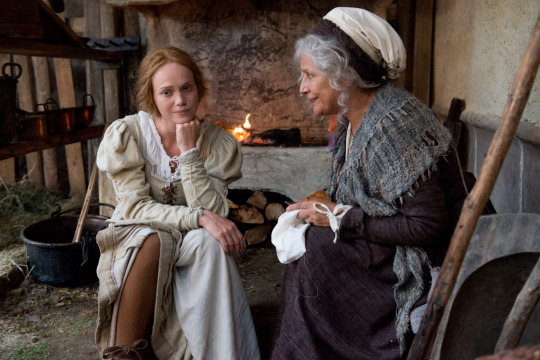
režie: Juraj Nvota | hrají: Dominika Morávková, Emília Vašáryová, Ondřej Vetchý, Filip Cíl, Szidi Tobias, Kristína Peláková, Ondrej Hraška
„Pohádka začíná ve chvíli, kdy přijde na svět děťátko a ke kolébce spěchají tři sudičky. Jedna má Johance do života darovat výjimečné vlastnosti, druhá překážky na cestě životem a třetí naděluje štěstí. Co se ale stane, když poslední ze sudiček svůj úkol nesplní? V pohádce plné napětí, humoru a překvapení se o tom na vlastní kůži přesvědčí její hlavní hrdinka, šikovná a sympatická Johanka. Chamtivý strýc a zlý bratranec se k Johance nechovají hezky, naštěstí proti nim zasáhne spravedlivá víla Tea. Jak už to tak v pohádkách a někdy i v životě bývá, je to především velká láska, která pomůže také Johance zdolat všechny překážky osudu. Nebude to ale snadné…“ (ČSFD, 45 %)
Království potoků (2005)

režie: Pavel Jandourek | hrají: Vladimír Javorský, Ota Jirák, Jakub Prachař, Radek Holub, Ondřej Pavelka, Jana Krausová, Petr Kostka
„Vládce Království potoků se ve zralém věku hodlá oženit. Rozhoduje se mezi dvěma panovnicemi sousedních království a jak to bývá, netuší v tu chvíli, že jeho volba nadlouho předznamená budoucí děj. Narodí se mu syn, který se později, už jako mladý muž, vydá na cestu za láskou. Nebyla by to ovšem pohádka, kdyby se o vše nemusel zasloužit a kdyby v tom všem, co prožije, nebylo nějaké osudové předurčení. Do děje podstatně zasahují patroni království Potok a Potůček, kteří doprovázejí prince, radí mu a pomáhají.“ (ČSFD, 39 %)
Krakonošovo tajemství (2022)

režie: Peter Bebjak | hrají: David Švehlík, Leona, Jan Nedbal, Ondřej Sokol, Dominika Morávková, Jakub Prachař, Martin Huba
„Na zámek v podhůří Krkonoš přijíždí nový majitel Štěpán se snoubenkou komtesou Blankou a mladším bratrem Adamem. Cestou kočár nešťastně srazí kolemjdoucí dívku Lidušku, Adam jí pomůže a ona se do něj zamiluje. V horském městečku je ještě jeden nový příchozí, národopisec Jiráček, který sbírá místní pověsti a nevychází z údivu nad tím, že zdejší lidé ještě věří v Krakonoše. Díky Adamovi Liduška získá místo zahradnice na zámku, jenže také brzy zjistí, že Adam je beznadějně zamilovaný do Blanky. Sobecký a lakomý Štěpán se dozví od Jiráčka o nevídaných pokladech skrytých v krkonošských horách a je odhodlaný je získat, zvlášť, když Adam náhodou objeví vlašskou knihu, která pomocí tajných značek popisuje, jak se k nim dostat.“ (ČSFD, 66 %)
O zakletém králi a odvážném Martinovi (2018)
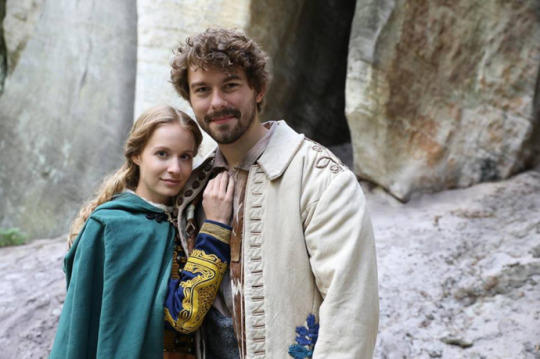
režie: Peter Bebjak | hrají: Richard Autner, Simona Kollárová, Tomáš Maštalír, Lukáš Vaculík, Ján Gallovič, Csongor Kassai
„Král je těžce nemocný a když se jeho jediná dcera, princezna Michaela, dozví o zázračné koruně krále Svaroga, která by mohla jejího otce uzdravit, vydá se najít Svarogovo začarované království. Cestou se zastaví v jedné vesnici, protože potřebuje okovat koně a nabrousit meč. Kovářem je tu Martin, dobrosrdečný a pracovitý mládenec, který se princezně na první pohled líbí. Když pochopí, že je slepý, o to větší obdiv k němu pocítí. Po pár dnech se ve vsi objeví kůň bez jezdce a Martinovi dojde, že princezně se něco zlého přihodilo. Vezme koně a vypraví se hledat princeznu Michaelu. Cestou se k němu přidá šikovný skřítek, který mu za sladkou buchtu poskytne dobré rady a veselou společnost. Přestože Martin nevidí, dokáže si poradit se všemi překážkami, které mu mají zabránit dojít až do Svarogova království, se zákeřnou ježibabou i se svým největším protivníkem, mocným čarodějem Vlkanem, původcem všeho zla.“ (ČSFD, 66 %)
Peklo s princeznou (2009)

režie: Miroslav Šmídmajer | hrají: Jiří Mádl, Tereza Ramba, Petr Nárožný, Václav Postránecký, Zlata Adamovská, Martin Stránský
„Princezna Aneta se nechce vdávat – a už vůbec ne za nešikovného prince Jeronýma ze sousední země, kterému byla jako dítě zaslíbena výměnou za vojenskou ochranu království před výbojnými nájezdy. Král Leopold by rád dceru uchránil před nechtěným sňatkem, ale nemůže porušit královský slib. Zrušení svatby by znamenalo válku s mocným vojevůdcem, králem Bedřichem. A tak Leopold vymyslí velkolepou lest: pošle sousedovi zprávu, že se o princeznu uchází sám Lucifer. Netuší ovšem, jakou lavinu nepředvídatelných okolností spustí, že vyvolá nejen hněv pekla, ale hlavně Muribany, žárlivé nevěsty samotného Lucifera...“ (ČSFD, 61 %)
Sněžný drak (2013)

režie: Eugen Sokolovský ml. | hrají: Petra Tenorová, Petr Lněnička, Martin Myšička, Saša Rašilov, Jitka Čvančarová, Arnošt Goldflam
„Romantická pohádka vypráví o princezně, která vyrůstala bez matky. Její otec, vlídný a spravedlivý král, dceru nadevše miluje, ale chce ji za každou cenu provdat. V den jejích dvacátých narozenin uspořádá na zámku velký ples. Na něm se o princeznu uchází řada princů, ale ten, pro kterého se princezna sama rozhodne, se jejímu otci z nepochopitelných důvodů nezamlouvá. A nikdo vlastně neví proč. Pak vyjde najevo, že za vším stojí dávná kletba vládkyně Říše čarodějnic a Sněžný drak. Princezna Laura se tak musí se svým vyvoleným princem Janem vydat na nebezpečnou cestu a překonat řadu překážek, aby nakonec zjistili, že nad zlem může zvítězit jen skutečná a pravá láska.“ (ČSFD, 48 %)
Svatojánský věneček (2015)

režie: Jiří Strach | hrají: Jiří Mádl, Eliška Jansová, Ivan Trojan, Bolek Polívka, Pavel Liška, Jan Vondráček, Marek Taclík, Jaroslav Plesl
„Sňatek princezny Verunky má zachránit království zchudlé kvůli bláznivým nápadům svého panovníka. A nápadníků má hned několik! Básník Alexandr Alexandrovič, ze kterého by i Puškin bledl závistí, dvouhlavý baron, vojevůdce a hudební skladatel v jednom Wajsman , tajemný Markýz, vládnoucí kouzlem své matky, panovnice smrti Morany a podivínský vynálezce sir Klevr. Může být Ondra, kluk toužící po tom stát se plavcem na divoké vodě, jejich důstojným soupeřem?“ (ČSFD, 52 %)
#ultimátní vánoční pohádka#pohádky#český film#slovenský film#česká televize#slovenská televízia#český blog#český tumblr
13 notes
·
View notes
Text

❂ isaac , fawn boy, system little ❂
agere and some petre (fawn, fox , rabbit, pup, dove)
interests ⋆ drawing/painting , exploring+nature, reading, history, cooking and baking, clothes/ costumes/ dress up, gardening, tea, animals, psychology
fandom interests ⋆ dungeons and dragons, LOTR, dracula, args, iwtv/tvc, nbc hannibal, traditional & classic animation , horror , urban legends / cryptids, clinical trial
⚕️physically disabled + chronically ill , semiverbal .
i often use muted colors and may miss small details while making moodboards, sorry, photosenstive eeyes. :)

10 notes
·
View notes
Text
get to know me!
my name is Cat! I go by she/her and I’m bisexual!
basic dni…: anti therian, anti furry, zoos, maps, anti agere, anti petre, homophobes, transphobes, sexists, racists, pro shippers
thin ice: mlp fans, dream team/mcyt fans, mha fans
i’m in TONS of fandoms but my favorites are South Park and Spooky month!
my favorite music artists are Sabrina Carpenter, Melanie Martinez, Nessa Barrett, Ellise, Sub Urban, Tate McRae, and Marina!
i’m a Roy fictionkin (from Spooky Month)
my only friend on here so far is @childofthest4rzz but i’m open to making friends !!
i’m from sketchers united, i’m @.cat_pers0n on there :)
i’m dumb so PLEASE use tone tags
#get to know me#nessa barrett#melanie martinez#spooky month#sub urban#sabrina carpenter#bee and puppycat#south park#sketchers united#bisexual#ellise#marina#tone tags#fictionkin#tate mcrae
8 notes
·
View notes
Text

🖤🦇welcome 2 my blog🦇🖤
I’m Gabriel. I go by a variety of names but that’s what I use to introduce myself. I love horror, varieties of dark media, monsters, all kinds of shit. All that along with some other fun stuff.
Here’s what to refer to me as: masculine or feminine variants of the name “Gabriel” (Gabriel, Gabe, Gabby, Brielle, Bri, etc), Prospero (Perry), Valentina (Val, Tina)
I’m trans! 🏳️⚧️ (genderfluid!!)
I’m omnisexual (female pref)
I’m hispanic
IMPORTANT!
I am a minor aged (15-16), don’t be a creep. Thanks.
I happen to be neurodivergent. I’m hella sensitive to text-tone and I have a habit to take things like jokes literally. Tone tags are always helpful for me.
I have a girlfriend! (Love u girlie 💜)
ABOUT ME
LIKES: Art, character designing, writing, character writing, story writing, music, singing, acting, theatre, video games, horror, monsters, ghost/cryptid hunting, urban exploring, pro wrestling, monster trucks, cars, motorcycles, animatronics, etc
DISLIKES: Certain food textures, when people repeat themselves too much (kind of a hypocrite since I have vocal stims 😭), vacuuming, a lot of bugs (though I find them cool, just don’t wanna be around some of those fuckers)
HORROR FANDOMS: Classic slasher films (ft13, scream, halloween, etc…) and really any other horror film, analog horror (twf, mc, ghe, etc…), universal monsters, brainrot mascot horror (ex: FNaF, BATIM, Tattletail), other horror games! (ex: DBD, Resident Evil, Silent Hill) a variety of horror associated television shows (ex: AHS, Hannibal, Supernatural, anything Mike Flanagan), tons of vampire media (ex: WWDITS, IWAV, Buffy), Creepypastas (including roblox myths!)
NON HORROR FANDOMS: CoD, TLO, TWD (kind of horror?), GTA, TMNT, Fallout, Deltarune + Undertale, Newgrounds, Regretevator, Homestuck, Invader Zim, Villainous, DC comics and Movies, MLP, South Park, Sonic, Rockafire, etc
MUSIC: Misfits, Iron Maiden, Pantera, Black Sabbath, Rob Zombie, Nirvana, Pink Floyd, RHC, Sublime, Will Wood, Tally Hall + Miracle Musical, Chappell Roan, Rico Nasty, Tyler The Creator, Childish Gambino, Ben Folds, Beach House, Siouxise and The Banshees, Depeche Mode, Bauhaus, Marina and The Diamonds, Melanie Martinez. (A LOT more, just wanted to hit some big ones)
5 FACTS ABOUT ME:
My favorite color is purple (This changes a lot tbh)
My favorite food is sushi
My favorite animals are bats, hyenas, pigs, possums, and rats
I have glasses.
DNI: Proshippers or Anti-Proshippers (you guys both suck), Nazis, Zionists, Terfs Alfred’s Playhouse, NSFW/18+ accounts (seriously go away), Anti Therian, Anti Neos and Xenos, Anti agere and petre
FREE PALESTINE 🍉
Feel free to say hi or whatever! Love to talk!
9 notes
·
View notes
Text
Revamped Sigurd reference sheet(Hellsing AU Lore bits included) Mature content ahead btw
Name(s) of character and explanations:
1: Sigurd Fenryka Magnusson (primary full name given by his father Petr Odayev Aleksander, nicknamed Magnus, and his uncle Wayland Gunther)
2: Constantine Valdorius Pendraco (Secondary full name given by his mother Irene Adriana Pendraco and grandfather Anarawd Pendraco)
The reason for his two full names is that it's a Welsh cultural (at least for my au) norm for families/clans to name their child with two full names to confirm their union in a marriage once it bears a child, thus unifying the two families together.

Art Credit: @v4nt4bl4ck On tumblr as name is shown)
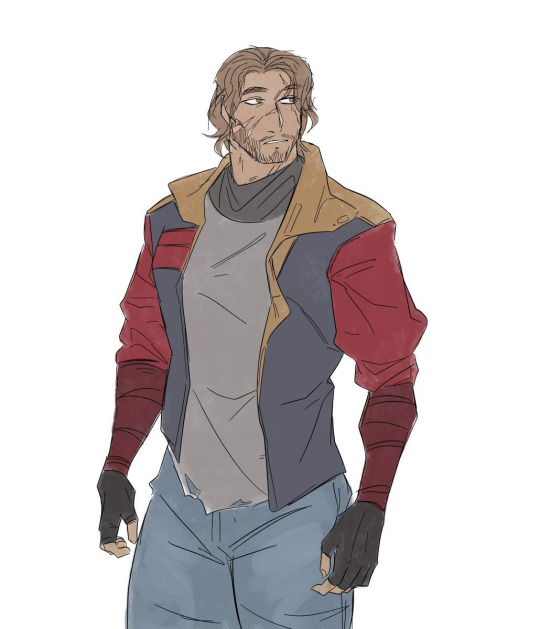
and this one from @cry-ptidd
Classification: Thor Class Supersoldier, Psychically gifted individual.
Species: Human, infected with a curse from a Varcolac (Werewolf/vampire hybrid creature)
Condition and medical treatments: Undiagnosed ADD/Autism, treated Rage addiction, werewolf/vampire hybrid curse with wolfsbane pills and UV light treatment to keep the beast(s) at bay, and a fully enacted super soldier implantations and treatments to help his body grow into the curse so his body wouldn't be ripped apart by physical mutation and enhanced growth.
Age: in 1999 he'd be 20 years old, birth date is January 7th, 1979.
Gender: Male (amab) pronouns being he/him. He's pretty comfortable with how he was born but he does have some oddities he's got in this sort of identity he's got.
Sexuality and Kinks: Considered himself straight for most of his life but realized he was Pansexual/Bisexual when one of his best friends came out to him and they started dating for a little while. He's discovering more about himself each day in that department, especially since he's a confident switch in the dynamics.
NSFT part: He's got a breeding kink, some light bdsm, brat taming, competitive sex, fight play, biting kink, exhibitionism, and other loosely tied kinks as well.
Voice claim: Aiden Caldwell from Dying Light 2
youtube
Scars/body details: Incredibly chiseled and well muscled due to genetic modification, scars all over from scratches, deep cuts, stabs, gunshot wounds, notable scars on his face over his right eye and two parallel cut scars diagonally rising from his jaw to his nose, and a large bite wound at his side. He is also covered in Norse-style tattoo at the front of his body to help keep his powers in check and as a retelling of his life story since the 5 years of war beginning in 1994 after what he thought to be a temporary vacation when he met his first love Seras Victoria and was with her for a month while she was in the orphanage. Then he continued the rest of his trip with his older brothers to a huge medieval-themed festival in Kosovo and all the way to his oaths to avenge his oldest brother Joshua. Only for them to be dragged into the grim plans of millennium's schemes for their war against Alucard, England, and then the world. Years of conflict and loss painted his body with not just scars but with tattoos as well. Each rune recounted atoning for old shames and liberating lost lands from vampire hordes spurned on by rebellions in the Balkans. These things are how he bares his soul to those who truly begin to know him. He also has a wedding ring on his finger, though he won't talk much about it to anyone.
Personality: Strangely positive, yet still marked by a deep determination fueled by his grim past. He's also remarkably calm under most pressure he faces. He also feels very strongly about injustices against people and will vocally stand up for more vulnerable, oppressed people since he is deeply anti-authoritarian. He's also very gentle with most people since he still has a hard time gauging his own strength in some moments. He's also a massive adrenaline junkie too, often doing things like parkour in Urban environments if bored enough or maybe something like hunting dangerous games with minimal equipment in rural areas. He's overall a very casual, fun person to be around like Pip would be in Hellsing. Though, with people who would be his sexual/romantic partners, he is much more sensual in his mannerisms. For a morally grey-ish character, he's turned out better than most of the other characters in the Hellsing universe as a whole.
Powers/abilities: He's not only stupidly strong since he's a super soldier but he also has some psychic abilities. One is that he can instill panic/general emotional distress into people around him. It's almost like a full-power sonar blasted in a general area or directly aimed at a spot and you're underwater when it happens as a diver. It's not just loud, it's disorientating, literally to the point you get sick or possibly even die underwater from drowning. Sigurd's powers of course aren't exactly like that, but it's just a heavy, smothering presence in the air that makes you feel like walls are closing in around you. He's caused people to have heart attacks before at its worst. So not only can he bench press a whole-ass black bear and leg press one too, but he would also scare you half to death by getting a little frustrated at you. So he's had to really tone himself back from his angrier past. Another ability he has is being able to communicate to most animals due to his curse.
Professions: To put it bluntly this guy would put the famous doctor, surgeon, therapist, plumber, professor, mechanic, pizza delivery guy, etc Johnny Sins look like a chump. Sigurd's been a commander of entire armies before and more than that too. But he's also had a very humble background in more working-class jobs like being a butcher, factory worker, and construction worker, even tried working in fast food but quit after a week when calling a rude customer a "rambunctious hoe" and slapping his boss across the face for being a dick about it. He's also been a mercenary before for a short period of time during the beginning of the war he was in. He was also a sex worker of sorts after his 19th birthday. So yeah he's had a wild time. Finally, he's found a new job with Hellsing after a war in Italy when Alucard fought him to a near stalemate until Sigurd ran out of steam and surrendered after sending his soldiers away. And instead of being executed, he was spared to recruit him and see what he could do.
(more might be added soon since I posted this at 2:45 am or whenever, kinda going stir crazy)
#hellsing oc#oc ref#ref sheet#under construction-ish#not my art#Youtube#oc#my oc#sigurd my beloved#years of work now laid bare#hope y'all like it btw#hellsing
5 notes
·
View notes
Text
THE WORLDS: Di'Xyne²
The Pyr Lands

The Pyr Lands are the largest nation of the 4 as during their industrialization era, they sought to expand their borders for resource rich areas before the other nations could catch up, hitting hard and fast with cutting edge weapons and warfare.
Since then, they’ve made themselves the capital leaders using mass production and their constant need for rapid technological advancement. On top of that, they have culled monsters nests and wildlands in order to rapidly urbanize as much of the continent as possible. Their imperial might is second only to the Petr Kingdom. Their capital is Pyrise, the most populated city on the planet, and sits close to the Volutan border.
It’s the highlight of modernity but with that comes problems ranging from 1st World woes, to systemic issues on a scale that your average layman knows nothing about. The major issues being the lack of updated worker’s rights and the resources needed to keep up this ideal of infinite growth interrupts the spiritual flow of nature in these areas, which leads to conflict with citizens and the colonies. One of the major controversies of note currently being the placement of Aether Reactors closer and closer to mainland settlements.

Even so, this land is still full of magic, just under the surface. Places yet untouched. Mysteries left to be found. And there are still quite a few who know just how to bring it forth. Much of it is hidden under roadways and scaling buildings but if you peel back the layers, you’ll find it.
3 notes
·
View notes
Note
Aside from your urbanism book in your blog description, what are some of your favorite authors?
I'm currently reading through murray bookchin's bibliography so recommend him. As well, Jane Jacob's The Life and Death of Great American cities is a classic, though I probably wouldn't consider her a favourite cause I have some beef with The Economy of Cities.
As well, I enjoy Petr Kropotkin's writings as they're the basis of modern anarchism. I'll also recommend Engin Isin's cities without citizens as an excellent look at Canadian cities, though I've not read his other works. Another author who I can only speak to a singular book of is Andy Merrifield and his work Metromarxism.
Outside urbanism and political theory though, I love Ray Bradbury. I have a complete collection of his short stories which I think are criminally underappreciated compared to Fahrenheit 451.
2 notes
·
View notes
Text
One Final ESC 2023 Thought: Favorite Songs From Each Country (participating AND non-participating)!
AAAAA I'M SO SORRY FOR DISAPPEARING OFF THE FACE OF THE EARTH FOR A WHILE! I just...never got around to my finale before we get to some fun Junior Eurovision 2023/Eurovision 2024 stuff! So here is my finale: Where I share my favorite songs from each country in Eurovision from 2009 to the present.
So, how is this going to work? I'm going alphabetically because it's easier to do it like that. I'm giving you my top 2 from each country, but not the placements. If you want those, they're on the Eurovision website (I will put the year down though). Now, let's get to it!
Albania: "World" by Lindita (2017)/"Ktheju Tokës" by Jonida Maliqi (2019)
Andorra: "La Teva Decisió (Get A Life)" by Susanne Georgi (2009)
Armenia: "Future Lover" by Brunette (2023)/"Not Alone" by Aram MP3 (2014)
Australia: "Promise" by Voyager (2023)/"Sound Of Silence" by Dami Im (2016)
Austria: "Who The Hell Is Edgar?" by Teya & Salena (2023)/"I Am Yours" by The MakeMakes (2015)
Azerbaijan: "Hold Me" by Farid Mammadov (2013)/"Fade To Black" by Nadir Rustalmi (2022)
Belarus: "Forever" by Alekseev (2018)/"Eyes That Never Lie" by Petr Elfimov (2009)
Belgium: "Rhythm Inside" by Loïc Nottet (2015)/"The Wrong Place" by Hooverphonic (2021)
Bosnia & Herzegovina: "Korake Ti Znam" by Maya Sar (2012)/"Ljubav Je" by Jalal & Deen/Ana Rucner/Jala (2016)
Bulgaria: "If Love Was A Crime"/"Na Inat" both by Poli Genova (2016 & 2011 respectively)
Croatia: "Guilty Pleasure" by Mia Dimsic (2022)/"Tick Tock" by Albina (2021)
Cyprus: "Alter Ego" by Minus-One (2016)/"El Diablo" by Elena Tsagrinou (2021)
Czechia: "Lights Off" by Domi (2022)/"My Sister's Crown" by Vesna (2023)
Denmark: Øve Os På Hinanden" by Fyr og Flamme (2021)/"Only Teardrops" by Emmelie de Forest (2013)
Estonia: "Goodbye To Yesterday" by Elina Born & Stig Rastä (2015)/"Rändajad" by Urban Symphony (2009)
Finland: "Something Better" by Softengine (2014)/"Jezebel" by The Rasmus (2022)
France: "L'enfer et moi" by Amandine Bourgeois (2013)/"Évidemment" by La Zarra (2023)
Georgia: "Warrior" by Nina Sublatti (2015)/"Echo" by Iru (2023)
Germany: "Taken By A Stranger" by Lena (2011)/"Ghost" by Jamie-Lee (2016)
Greece: "Die Together" by Amanda Tenfjord (2022)/"Aphrodisiac" by Eleftheria Eleftheriou (2012)
Hungary: "What About My Dreams?" by Kati Wolf (2011)/"Running" by Andra Kallay-Saunders (2014)
Iceland: "Hear Them Calling" by Greta Salome (2016)/"10 Years" by Daði Freyr (2021)
Ireland: "Playing With Numbers" by Molly Sterling (2015)/"That's Rich" by Brooke (2022)
Israel: "Same Heart" by Mei Finegold (2014)/"Rak Bishvilo" by Moran Mazor (2013)
Italy: "La Mia Città" by Emma (2014)/"ZITTI E BUONI" by Måneskin (2021)
Latvia: "Aijā" by Sudden Lights (2023)/"Love Injected" by Aminata (2015)
Lithuania: "Stay" by Monika Linkyte (2023)/"Discoteque" by The Roop (2021)
*can't wait to see Luxembourg next year!!!*
Malta: "This Is The Night" by Kurt Calleja (2012)/"Je Me Casse" by Destiny (2021)
Moldova: "O Mie" by Aliona Moon (2013)/"Run Away" by Sunstroke Project & Olia Tira (2010)
Montenegro: "Adio" by Knez (2015)/"Breathe" by Vladana (2022)
Netherlands: "Arcade" by Duncan Laurence (2019) *CONGRATS ON 1B SPOTIFY STREAMS!*/"De Diepte" by S10 (2022)
North Macedonia: "Crno I Belo" by Kaliopi (2012)/"Jas Ja Imam Silata" by Gjoko Taneski (2010)
Norway: "Fairytale" by Alexander Rybak (2009)/"Queen Of Kings" by Alessandra (2023)
Poland: "Flashlight" by Kasia Moś (2017)/"River" by Ochman (2022)
Portugal: "Amar Pelos Dois" by Salvador Sobral (2017)/"Vida Minha" by Filipa Sousa (2012)
Romania: "Playing With Fire" by Paula Seling & Ovi (2010)/"Amnesia" by Roxen (2021)
*I would like to look into which artists do NOT support the war before sharing my favorites for Russia*
San Marino: "Adrenalina" by Senhit & Flo Rida (2021)/"Stand By" by Senhit (2011) *yes...same artist 10 years apart*
Serbia: "Samo Mi Se Spava" by Luke Black (2023)/"Goodbye (Shelter)" by Sanja Vučić ZAA (2016)
Slovakia: "Horehronie" by Kristina Pelakova (2010)/"Don't Close Your Eyes" by Max Jason Mai (2012)
Slovenia: "Carpe Diem" by Joker Out (2023)/"No One" by Maja Keuc (2011)
Spain: "Quedate Conmigo" by Pastora Soler (2012)/"Dancing In The Rain" by Ruth Lorenzo (2014)
Sweden: "Heroes" by Måns Zelmerlöw (2015)/"Popular" by Eric Saade (2011)
Switzerland: "Tout l'univers"/"Répondez-moi" both by Gjon's Tears (2021 & 2020 respectively)
Turkey: "We Could Be The Same" by maNga (2010)/"Dum Tek Tek" by Hadise (2009)
Ukraine: "Under The Ladder" by Mélovin (2018)/"Time" by O. Torvald (2017)
United Kingdom: "I Wrote A Song" by Mae Muller (2023)/"Never Give Up On You" by Lucie Jones (2017)
Thank you so much for joining me this year! Looking forward to the new year of Eurovision stuff!
#esc#eurovision song contest#eurovision#esc 2023#eurovision 2023#esc2015#esc2014#esc2016#esc2009#esc2010#esc2021#esc2011#esc2022#esc2012#esc2013#esc2017#esc2018#esc2019#esc2020
2 notes
·
View notes
Text
INTRODUCTION POST :0
*The Basics*
My names are Alexander or Ivan, feel free to use any nicknames associated w either of these
My pronouns are he/ruff/pup (el/el or il/lui also work!)
I speak English, Spanish and French but I'm a bit rusty with spanish and french..
I mostly listen to post hardcore, pop punk, and Alternative/Indie
I have OCD, Autism and I'm extremely prone to paranoia, so..BEWARE!!!
*Likes*
[ GENERAL ] Dan and Phil, Sharks, The Ocean in general, Musicals, bein emo, writing, drawing, trains, the color blue and Urbanism
[ MUSIC ] MCR, PTV, BMTH, FOB, SWS, Set it off, Heartwell Ending, Simple Plan, Scary Kids Scaring Kids, Properties of Nature, I Met a Yeti, Chiodos, Evanescence, CIWWAF, NSN, A Thorn For Every Heart, Icon for Hire, The Killers, Creature Feature, Trashy 2010s pop (ahaa i totally listen to kesha ironically......). Then as for Alternative Indie my favorites are of Montreal, Miniature Tigers, They Might Be Giants, and The Apples In Stereo
[ GAMES ] Minecraft, Roblox, Undertale, Pokemon, Sonic, FNAF, Deltarune, TLOZ, and Ace Attorney
[ SHOWS ND MOVIES ] Yuri on ice, Breaking Bad, Better Call Saul, MLP, Invader Zim, No.6, Steven Universe, Gravity Falls, and Alien Stage
These are just the things I'll post about the most...for a better list look on my spacehey!
*My DNI*
racist, homophobic, any of that shit (obviously)
hoyoverse supporters
pro/com/whatever the fuck shippers
anti agere / petre
people who call themselves "proud assholes", or anything like that
terfs, transmed, transcum, etc
other than that, if i don't like you, i'll probably just block you (other than this list, its nothing personal)
*My Tags*
lex rambles // me spewing dumb shit ....
lex's blinkies // my blinkies!!
lex does thing // my general creations
*My other socials*
The only social other than tumblr i'm active on is my spacehey
AAAHHHH!! My apologies for this being so long, but I finally have one :0
1 note
·
View note
Text
Sunday, September 15, 2024
The disaster our cities are not prepared for (Washington Post) For days, residents of Houston struggled to survive as temperatures rose. They shared generators, filled buckets and bathtubs with ice, packed air conditioned hotels and emergency rooms. The most vulnerable struggled to get the care they needed. Many died. But in some ways, Houston was narrowly spared. Temperatures rose to the high 90s, but only for a couple of days. If the heat had stayed, the human toll could have been far worse. Experts warn this type of catastrophe—a combined power outage with a heat wave—is a scenario that cities and states are unprepared for. “I don’t think it’s likely—I think it’s an absolute certainty,” said Brian Stone, a professor and director of the Urban Climate Lab at the Georgia Institute of Technology. “I think it’s an absolute certainty that we will have an extreme heat wave and an extended blackout in the United States.” The Washington Post analyzed the risks of a prolonged, citywide blackout coinciding with a more severe heat wave. The results show that such a heat wave could kill between 600 and 1,500 people in the Houston metro area over five days. With the power grid working normally, the same heat wave would lead to around 50 deaths.
Mexico’s president asks Sinaloa cartel to act ‘responsibly’ as violence escalates in the north (AP) Mexican President Andrés Manuel López Obrador on Friday asked the warring factions of the Sinaloa cartel to act “responsibly” so no one else gets killed, after a week of escalating violence nearly paralyzed the Sinaloa state capital, Culiacan. Asked by a journalist if he trusted that the cartels would heed his call, López Obrador answered bluntly: “The president of Mexico is always listened to.” “Even by criminals?” pressed the journalist. “By everyone, more so if one has moral authority,” responded the president. The president, who leaves office on Sept. 30, has repeatedly refused to confront cartels, laying out various justifications for his “hugs, not bullets” strategy offering opportunities to youths so they won’t join cartels. The latest clashes in Culiacan are the latest example of the violence that continues to plague Mexico, where cartels employ increasingly sophisticated forms of warfare including roadside bombs or IEDs, trenches, home-made armored vehicles and bomb-dropping drones.
Seeking affordable housing in tourist hotspots (Reuters) Two European tourist and expat hot spots are trying different approaches to make housing affordable for their citizens. Greece will offer tax breaks to homeowners who convert their rentals to long term from short. Portugal is simply creating more supply by budgeting more than $2 billion to build 33,000 homes by the end of the decade.
Prague on high flood alert as central Europe faces torrential rain (AP) Prague was putting up flood defences in the city’s historic centre on Friday after Czech forecasters expanded a warning for extreme rainfall to areas of the country including the capital, which suffered catastrophic flooding more than 20 years ago. Heavy rain has pounded mostly eastern parts of the Czech Republic since Thursday, and the most affected areas may see more than a third of annual rainfall over four days by Sunday. Similar weather has been forecast around central Europe, including southern Germany and parts of Austria, Poland, and Slovakia over the coming days. “Data shows we are facing uneasy days,” Czech Prime Minister Petr Fiala told a televised briefing after a crisis committee meeting, adding that in some places water levels may exceed flooding coming on average once in 100 or more years.
Russia expels six UK diplomats as tensions rise over Ukraine missiles (Reuters) Russia’s FSB security service said on Friday it had revoked the accreditation of six British diplomats in Moscow after accusing them of spying and sabotage work, signalling the Kremlin’s anger at what it sees as London’s vital role in helping Ukraine. Britain described the accusations as “completely baseless”, saying it was a tit-for-tat action after the UK expelled the Russian defence attache and removed diplomatic status from several Russian properties in May. Russia announced the expulsions hours before British Prime Minister Keir Starmer met U.S. President Joe Biden at the White House, a crucial step towards winning the go-ahead for Kyiv to use long-range missiles against targets in Russia.
India’s top court releases New Delhi’s chief minister on bail after 6 months in jail (AP) India’s top court on Friday freed on bail Arvind Kejriwal, a prominent opposition leader and chief minister of New Delhi, who was arrested nearly six months ago ahead of national elections on charges of receiving bribes from a liquor distributor. Kejriwal is the leader of the Aam Aadmi Party, or Common Man’s Party, which governs New Delhi. He is one of India’s most influential politicians of the past decade and a fierce critic of Prime Minister Narendra Modi. Kejriwal was initially arrested in March, weeks before the national elections. He denied the accusations and called them a political conspiracy. Kejriwal’s party is part of a broad alliance of opposition parties called INDIA which was the main challenger to Modi’s Hindu nationalist Bharatiya Janata Party in the elections, which concluded in June.
Pope’s Asia Tour Points Toward a Less-Western Church (NYT) Over the last couple of weeks, Pope Francis hoisted himself up on sore legs dozens of times. As he crisscrossed large swaths of the Asia Pacific region, he shuffled from cars to his wheelchair, from the wheelchair to makeshift papal thrones and on and off many planes as hot, tropical winds blew on the tarmac. The trip amounted to the longest and farthest reaching yet for Francis, and at 87, some of his supporters fear it may be one of his last. But that he flew thousands of miles to Asian countries with relatively small Catholic populations, braving oppressive temperatures and high levels of humidity and pollution, underlined Francis’s commitment to building a church with a less Eurocentric future. “The long distance, the fatigue, the challenges,” said Cardinal Michael Czerny, a close aide to Francis. “They are part of the message.” His purpose, he has long made clear, is to emphasize outreach and inclusivity. As he visited remote, tropical villages in Papua New Guinea, he put in practice his pledge to embrace what he calls the church’s “peripheries,” faraway, minority or poorer Catholics.
China raises retirement age (CNBC) China will raise retirement age for the first time since 1978. The country’s top legislative body has approved proposals to “gradually raise” the retirement age from 60 to 63 for men, 55 to 58 for women in white-collar jobs and 50 to 55 for women in blue-collar jobs. The move aims at addressing China’s shrinking population and aging workforce. The policy change will be carried out over 15 years, starting in January 2025. China’s current retirement ages are among the lowest in the world.
Women in Iran are going without hijabs as the 2nd anniversary of Mahsa Amini’s death approaches (AP) On the streets of Iranian cities, it’s becoming more common to see a woman passing by without a mandatory headscarf, or hijab, as the second anniversary of the death of Mahsa Amini and the mass protests it sparked approaches. There’s no government official or study acknowledging the phenomenon, which began as Iran entered its hot summer months and power cuts in its overburdened electrical system became common. But across social media, videos of people filming neighborhood streets or just talking about a normal day in their life, women and girls can be seen walking past with their long hair out over their shoulders, particularly after sunset. This defiance comes despite what United Nations investigators describe as “expanded repressive measures and policies” by Iran’s theocracy to punish them—though there’s been no recent catalyzing event like Amini’s death to galvanize demonstrators.
Underage, Under Fire (AP) JENIN, West Bank—In the web of battered, sun-baked streets winding up the hillside, bloodshed is as unrelenting as the heat. So it is not hard to see why, when raid sirens and gunfire erupted yet again on a morning in late May, 15-year-old Mahmoud Hamadneh turned his bike down an alley that held out the promise of refuge. “He didn’t do anything. He only had his books and a pencil case,” says Amjad Hamadneh, whose son, a buzz-cut devotee of computer games, was one of two teens killed that morning in the opening minutes of a raid by Israeli forces. More than 150 teens and children 17 or younger have been killed in the West Bank since Hamas’ brutal attack on communities in southern Israel set off the war last October. Most died in nearly daily raids by the Israeli army that Amnesty International says have used disproportionate and unlawful force. At the same time, Israel, which has long jailed Palestinians from the West Bank without charge, has extended that practice to many more teens. After October, food deprivation, overcrowding of cells and other mistreatment escalated sharply, the recently released and advocates say.
The sweet success of banana wine (BBC) A small-scale farmer in northern Malawi, Emily Nkhana used to discard over-ripe bananas or just let them rot, but she has now found a profitable use for them—banana wine. Extreme heat was causing bananas to ripen too quickly, resulting in heavy losses for Ms Nkhana and many other farmers who live in Karonga district. “Then we discovered how to make banana wine,” she tells the BBC, as she peels lemons that would be used to preserve the taste of bananas at the processing plant of Twitule Cooperative Group. For the farmers, it is not just about making wine—but also survival, resilience, and embracing the new possibilities that come with a changing climate. The banana pulp misture is left to ferment for several weeks, transforming the banana pulp into a potent, aromatic wine, containing 13% alcohol—similar to wine made from grapes. “It’s smooth and light, almost like a dessert wine,” says Paul Kamwendo, a local wine enthusiast who has become one of the biggest fans of banana wine in Karonga. “I had no idea one could make wine out of bananas.”
Harvest Moon (Space.com) Look up on September 17! The Harvest Moon, the full moon closest to the fall equinox, will experience a slight lunar eclipse, a foretaste of the ring eclipse of the sun on October 2. The name “Harvest Moon” comes from a time before electricity and agricultural machinery, when farmers relied on the moonlight to harvest crops through the night and work more when their cultivations were the most bountiful.
Studies on pigeon-guided missiles, swimming abilities of dead fish among Ig Nobels winners (AP) A study that explores the feasibility of using pigeons to guide missiles and one that looks at the swimming abilities of dead fish were among the winners Thursday of this year’s Ig Nobels, the prize for comical scientific achievement. Held less than a month before the actual Nobel Prizes are announced, the 34th annual Ig Nobel prize ceremony at the Massachusetts Institute of Technology was organized by the Annals of Improbable Research magazine’s website to make people laugh and think. Winners received a transparent box containing historic items related to Murphy’s Law—the theme of the night—and a nearly worthless Zimbabwean $10 trillion bill. Actual Nobel laureates handed the winners their prizes.
0 notes
Photo

by Gioacchino Petronicce https://flic.kr/p/qo6Vze
1 note
·
View note
Text
Demolitions
for Czechoslovakia’s architectures between 1960s–1980s is a controversial subject. The public may still regard it negatively, owing to a lack of information or an adverse experience with the country’s regime before the Velvet Revolution.

Omnipol Building by Zdeněk Kuna, Zdeněk Stupka, Milan Valenta, Josef Zdražil, Ladislav Vrátník (1974–1979) | Photo © Kamil Warta, National Gallery Prague
youtube
Erosion of Transgas (2020) by NGP/Loom on the Moon
Helena Doudová, the curator of the exhibition NO DEMOLITIONS! Forms of Brutalism in Prague, presents Brutalism buildings in Prague that prominently enter the urban scene. The nearly two hundred and fifty original architectural plans, photographs and models come mostly from the Architecture Collection of the National Gallery Prague. The examples of the most progressive architecture works feature the Kotva Department Store, the former Central Telecommunications Building at Žižkov (marked for demolition), the former Federal Assembly, Hotel Intercontinental and Barrandov Bridge and the recently demolished Transgas complex.
“No Demolitions!” is a quite straightforward title for an exhibition. What is happening in Prague and the Czech Republic, that led you to organize this exhibition and choose this title?
With the exhibition we intended to highlight the values of late modern and brutalist architecture in Prague that becomes either demolished or refurbished beyond the point of recognition. Some of the buildings ceased to exist throughout the one year since we started working on the topic. We intended to show that the buildings by the architects like Karel Prager, Karel Filsak, the husband-and-wife team Machoninovi and Šrámkovi have built edifices, which are comparable with the most prestigious architecture production of the former Western Europe and the US.

Center of Home Design by Věra Machoninová, Vladimír Machonin (1971–1981) | | Photo © Kamil Wartha, National Gallery Prague
The Trade Fair Palace is an exclusive choice for an architectural exhibition; why did you choose this location?
It is a building with strong symbolic meaning, a real jewel of functionalist architecture but at the same time it is difficult to present an exhibition due to technical parameters as light because paper plans and photography are very sensitive to it. The gallery floor plan worked quite well in a sequence, so the exhibition concept fit quite well. Ondřej Císler created vitrines with colored large plans and prints from the architecture collection of the National Gallery in Prague. Plans are contrasted with the photography of the deteriorated state of the buildings by Olja Triaška Stefanović.
In many countries of the former East Bloc, protecting Late Modern architecture creates a specific challenge, as these buildings are widely associated with the negative perception of the political era they were created in. This can very easily lead to iconoclastic gestures, as we have seen in the case of Skopje 2014. What can art history, museology and the wider profession do against this phenomenon?
The negative public opinion toward these buildings is a cluster of multiple problems. One general problem not only in the Central or Eastern Europe is the poor long term maintenance, which makes the buildings appear even more brutal than intended in the architecture design. As the exhibition shows, the architects were thinking of the public space around these buildings, inserted artworks and parks, as a number of designs show.
Secondly, the political associations are difficult, but also controversial to me. I very much think that the socialist state invested into large public buildings before 1989 and did provide socially accessible culture programs, sports, etc. So to me the brutalist buildings are valuable and authentic through their aim to belong to the community but also undercover propaganda. One can’t change people's memories or their experience with communism, but it’s not the fault of buildings that were ironically planned in the golden sixties in the time of the political détente in Czechoslovakia.
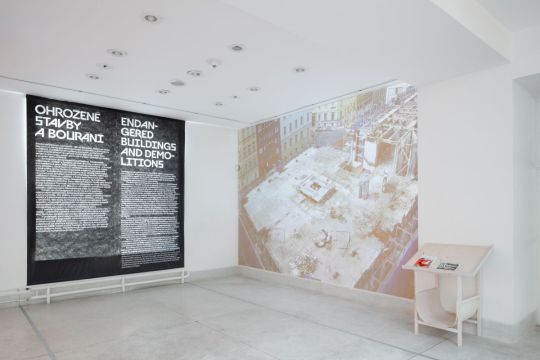



The exhibition | Photo © Katarína Hudačinová, the National Gallery Prague
In comparison, no large public building in Prague has been built since 30 years, what shows the shift of the capital flow with privatization. Nowadays, the real estate investors misuse the negative public opinion to demolish high quality buildings to acquire lucrative plots in the city centre for private investment. In many cases it would have been possible to reuse the brutalist buildings at a lower expense, like for example the Embassy of CZ in Berlin.
The National Gallery seems to be a prestigious place for the exhibition about the architecture of an era that is widely disputed and is also a strong institutional statement; how are Czech academics and professionals reacting to the events around the architecture of the 1960s, 1970s, 1980s?
I very much believe in the power of the exhibition as a tool for mediation and education, but also bringing up controversial or uncomfortable topics. That is the position the National Gallery has. Its architecture collection is centred around post-1945 architecture so it is logical to present it in an innovative perspective. Brutalism has received international acclaim in architecture history since 2010s, so we have had many academic discussions, but to me it is important to bring the phenomenon to the public. It is interesting that the expression is the same in former East and West, the only difference is that in the former West the buildings like the MET Breuer are celebrated, while in the former East these buildings are admired by the professionals and despised by the wide public.
In most of our countries we see the profession and the public speaking out to protect some of these buildings, in Hungary this happened by the proposed demolition of Zoltán Gulyás’ Chemolimpx office building in the early 2010s, and more recently when the government announced the demolition of Csaba Virág’s soc-hi-tech Electric Power Distribution Center. There are similar stories in Czechia and Poland - how do you explain the public being so involved in these cases?
Yes, there is an entire movement of active architecture historians, architects and interested public. David Crowley, the head of arts department of the NCAD in Dublin, is a great observer of these shifts, which demonstrate a renewal of the consciousness for public sphere and public spaces in general. So far the protests have been unsuccessful in confrontation with the investment pressures, a culmination point was the demolition of the Transgas building, public protests accompanied the demolition of Hotel Praha, and eventually rescued railway station in Havířov. Crowley says this a unique trait in Central Europe as he has not seen such engagement in the UK or Ireland. In Germany, the heritage protection of post-war buildings is really advanced by now, but there are not such strong public initiatives to me...
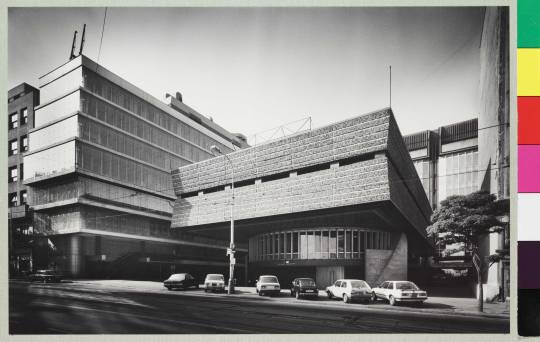

Transgas Complex by Ivo Loos, Jindřich Malátek, Václav Aulický, Jiří Eisenreich, Jiří Kozák, Jan Fišer (1966–1978) | Photo © Kamil Wartha, National Gallery Prague
Why did you choose brutalism as a specific style to sum up these buildings? Strictly speaking, the term is quite well defined and confined to a specific group of mostly British and American buildings, what is brutalism in your definition?
The usual association is béton brut, with the main inspiration of Le Corbusier. At the same time, I took at hand Rayner Banham, who speaks about three criteria, in short – the figure, the revealed construction and authenticity of material, which would better comply with the notion of brutalism in variety. Also brutalism has been changing from the expression of the Smithson's Hunstanton school, to let's say Paul Rudolph. In such way brutalism became an international expression with multiple specifics.
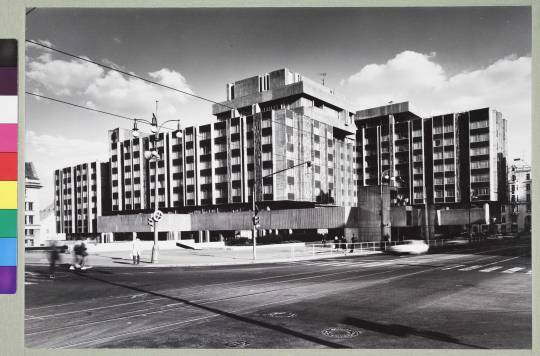
Hotel Intercontinental by Karel Filsak, Karel Bubeníček, Jiří Louda, Jaroslav Švec a kol. (1968–1974) | Photo © Kamil Wartha, National Gallery Prague
The notion of brutalism has been a subject of a dispute in the curatorial team with Petr Vorlík, Klára Brůhová (CTU Prague) and Radomíra Sedláková (NG Prague). We assumed the Czech architecture was influenced by brutalism, to a smaller or larger extent depending on every architect. Architecture of late modernism in Czech shows finer handling of material such as glass, mosaics, of wooden cladding, a variety of bright colours, that do not particularly express the notion of brutalism associated with rough concrete. The houses do in a way respect the scale of the surrounding city, are most often broken down in a composition of smaller volumes, reference bay windows of surrounding houses, etc.
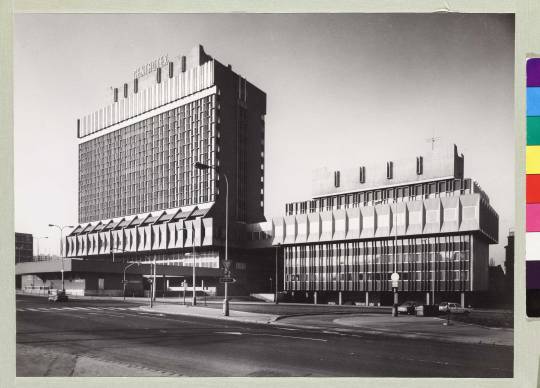
PZO Centrotex Building – Václav Hilský, Otakar Jurenka (1972–1978) | Photo © Kamil Wartha, National Gallery Prague
At the same time the label brutalism is in public drawn to all kinds of buildings, which have with little or nothing to do with late modernism, actually, are clad in stone. So as architecture historians we strived to differentiate and raise public awareness on the topic.
Is there a specific Czech brutalism? Are there any national or regional characteristics in this era?
This is not an easy question. Brutalism was a global and a local phenomenon. Interestingly, in the Czechoslovak architecture we see magazines that iconic brutalist buildings were published, like La Tourette, or the architecture by Stirling in the 1960s and 1970s. So the information iron curtain was more semi-penetrable in terms of architecture knowledge and expression, like Ákos Moravánszky says. The regional specifics construction processes, the quality and variability of materials, which was lower in the former Eastern block, and also the public opinion which incorrectly associates the buildings with state socialism.
We are talking about the architectural production of an era that produced an incredible amount of buildings. How is it possible to create a canon for such a recent past and what do you think about the monumental protection regarding these buildings? What should be protected and how? Can you also name a few example, interesting buildings (and interiors) from Czechia?
A unique example is the already heritage protected Kotva Department Store by architect's team Věra and Vladimír Machoninovi.

Kotva department store in Prague. | Photo © Olja Triaška Stefanović
The former Federal Assembly is another iconic example of a daring construction originally intended for bridges. It encloses the former classical modernist stock exchange building and complements the ensemble anew. Interiors have unfortunately been refurbished and only very few items are present in the museums.
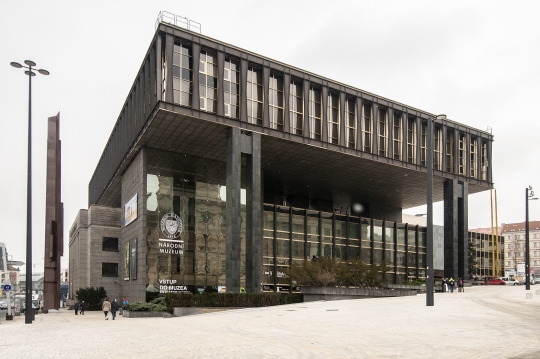
Former Federal Assembly Building Prague. | Photo © Olja Triaška Stefanović
A unique example is the Czech embassy in Berlin with intact interiors. A contested interior reconstruction is currently Hotel Thermal by Machoninovi in Karlovy Vary. At least five outstanding buildings have been demolished in Prague, countless have been refurbished. Only two above-named brutalist buildings are heritage protected, other like Hotel Intercontinental by Filsak, or Centrotex by Hiský, Motokov by Kuna should become protected as unique works of art and architecture.
___
Interview by Dániel Kovács and first published in Epiteszforum.
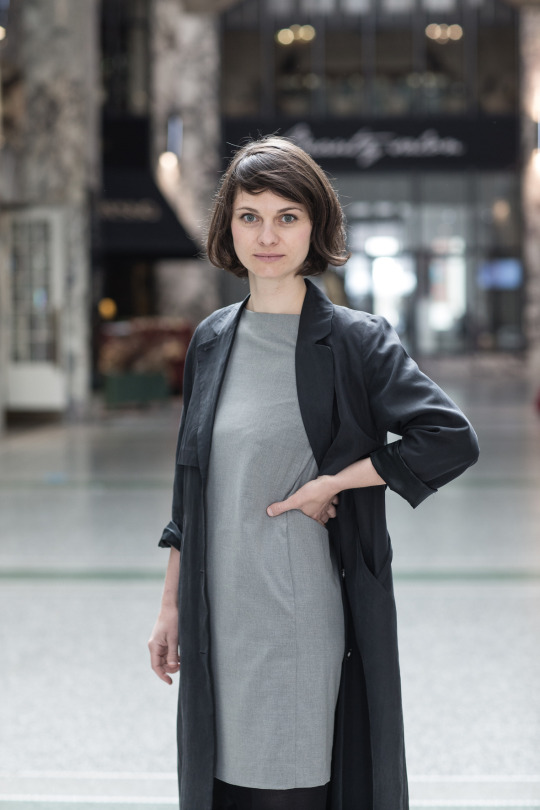
Photo © Jan Faukner
Helena Doudová is curator of the Architecture Collection of the National Gallery Prague. She gained curatorial and museum experience as research and curatorial fellow of the International Museum Program in the German Museum of Books and Writing in Leipzig in collaboration with the University of Erfurt and the German Federal Cultural Foundation 2016/2017, as a Robert Bosch Fellow at Architecture Museum of the TU Munich – Pinakothek der Moderne (2011–2012) and as an intern in the German Architecture Centre DAZ in Berlin (2013–2014). She initiated and curated NO DEMOLITIONS! Forms of Brutalism in Prague, Baugruppe ist super!, Image Factories: Infographics 1920-1945: Fritz Kahn, Otto Neurath. She is a PhD candidate at the Institute of Art History of the University of Zurich. She was awarded DAAD research scholarship and Aktion Österreich scholarship.
***
NO DEMOLITIONS! Forms of Brutalism in Prague
From 6.3.2020 to 22.11.2020 at the Trade Fair Palace – 3rd floor Dukelských hrdinů 47, 170 00 Praha 7 Map
Curator: Helena Doudová Collaborating experts / co-curators: Klára Brůhová (FA CTU in Prague), Radomíra Sedláková (NGP), Petr Vorlík (FA CTU in Prague)
71 notes
·
View notes
Text
The Exploding Cactus
There’s this urban legend going around about a person buying an exotic plant as a decoration for their home. Unfortunately, the plant comes with a dangerous surprise in the form of spiders, a snake, or other unpleasant critters hidden inside. The kinds of the plant and animals vary among different versions of this urban legend and they may vary even within one country.
Bengt af Klintberg uses an example story sent to him by a reader in 1990. The informant is from Trondheim and retells a story which he heard from his friend, who heard it from her hairdresser’s acquaintance.
The hairdresser supposedly bought a potted palm tree in an unspecified store. Upon bringing the palm home and watering it, the palm bent down as if it was thanking her for the water. The hairdresser’s friend also wished to have such a palm tree and ringed the store asking for “that one which bows down and thanks its owner”. But instead, the store sent a team of men in hazmat suits to take care of the hairdresser’s palm because this behaviour wasn’t normal. They sprayed the palm with poison and pulled it out of the pot. A long snake fell out of the trunk. It presumably hatched out of an egg in the tree while it was being transported to Norway and then hid in the tree. The movement of the trunk was caused by the movement of the snake inside.
The Czech example provided in Petr Janeček’s collection of urban legends is quite similar.
It’s introduced as a story told by a friend of a friend about an exotic plant – this time a banana tree – bought in a local Baumax. The tree was making strange movements but the owners disregarded it as hallucinations caused by the drugs they took that day. However, the owners got a phone call from the police asking about the tree and soon a pest control team came. In the tree roots they found a tarantula guarding a bunch of eggs.
This urban legend it quite widespread in Europe. Its earliest roots go back to mid-1970s, when a story known as The Spider in the Yucca appeared. In September 1975 the Swedish evening newspaper Expressen reported a story about a spider hidden in a cactus bought somewhere abroad, and in 1977 a similar report came from Vienna. However, it was mainly in Sweden and Finland where this story was spreading fast. In 1983, Göteborgs-Posten, another Swedish newspaper, reported about a venomous spider hidden in a yucca plant and warned people about the possible dangers of buying exotic plants. Similar reports later emerged in Åbo and Stockholm.
Other countries where this story got popular were for example France, United Kingdom, and the Netherlands. In the UK, the seller of the dangerous plant was usually the Marks & Spencer chain. Other reported chains include Baumax, Obi, or Hornbach.
What happened in the story is of course not true. These exotic plants are grown in European greenhouses and undergo regular check-ups. The main source of this urban legend is a man’s mistrust for the foreign, and fear of possibly dangerous critters, such as spiders, and snakes.
-
Sources:
AF KLINTBERG, Bengt. Den hövliga palmen. Den stulna njuren. Norsteds förlag AB, 1994, s. 53-57. ISBN 91-1-949042-9.
JANEČEK, Petr. Zelené nebezpečí. Černá sanitka: To nejlepší ze současných pověstí a fám. Prague: Plot, 2009, s. 144-145. ISBN 978-80-7428-014-6.
6 notes
·
View notes
Text
© Filmy + Zakleté pírko (2020) Celý Film Online CZ a Zdarma
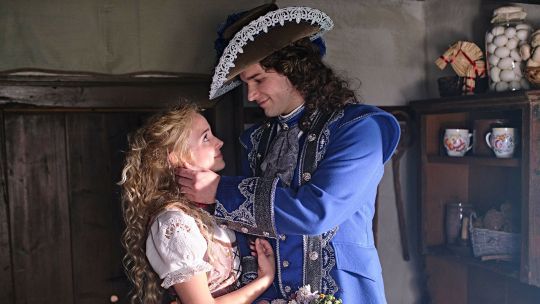
Sledujte Zde 🎬▶ https://server.dreams47.com/movie/642695/zaklet-prko.html
Aninka žije na statku se dvěma nafoukanými sestrami, kterým musí sloužit. Jednoho dne najde pírko, jehož pomocí si přivolá prince Vítka, zakletého do ptačí podoby. Když zlé sestry zjistí, že se Aninka schází s pohledným mladíkem, pírko jí vezmou, zničí a Vítek zmizí. Jedinou možností, jak zlomit prokletí, je, že ho Aninka najde kdesi ve světě. A tak se dívka vydává na cestu za záchranou svého milého. Jejím průvodcem se stává vodník, jehož na počátku putování zachrání před zlým sedlákem. Společně prožijí řadu dobrodružství i legrace. A přestože vodnická kouzla dokáží Anince pomoci, jak k uzdravení nemocných, tak na obranu proti loupežníkům, k záchraně Vítka bude potřeba především pravá láska
Režie: Zdeněk Troška Scénář: Marek Kališ, Zdeněk Troška Kamera: David Ployhar Hudba: Miloš Krkoška Hrají: Anastasia Chocholatá, Sara Sandeva, Lukáš Pavlásek, Šárka Vaculíková, Lucie Polišenská, Marek Lambora, Václav Svoboda, Martin Stránský, Dana Syslová, Jitka Smutná, Petr Urban, Jakub Volák, Václav Duchek, Andrea Hoffmannová, Michal Miki Grepl, Ladislav Dostál, Antonín Mašek, Jiří Bláha, Aneta Procházková, Viktorie Kožíšková, Zuska… (více) (další profese)
Zakleté pírko online bombuj, Zakleté pírko online cely film, Zakleté pírko online ke shlednuti, Zakleté pírko cz dabing online ke shlednuti, Zakleté pírko online, Zakleté pírko online film cz, Zakleté pírko Bombuj, Zakleté pírko bombuj cz, Zakleté pírko online ke shlédnutí, Zakleté pírko celý film cesky, Zakleté pírko celý film zdarma ke shlédnutí, Zakleté pírko celý film cz dabing, Zakleté pírko zkouknito, Zakleté pírko sleduj filmy, Zakleté pírko online cz titulky, Zakleté pírko Filmové Novinky, Zakleté pírko celý film Cesky, Zakleté pírko Filmové premiéry, Zakleté pírko celý film cz dabing, Zakleté pírko zkouknito, Zakleté pírko sleduj filmy, Zakleté pírko online cz titulky, Zakleté pírko Program filmy, Zakleté pírko CZ HD Film o filmu, Zakleté pírko CZ dabing, Zakleté pírko premiéra, Zakleté pírko online cz, Zakleté pírko online cz dabing, Zakleté pírko Zadarmo, Zakleté pírko Celý Film, Zakleté pírko Titulky, Zakleté pírko nový film, Zakleté pírko DVD filmy, Zakleté pírko Blu-ray filmy, Zakleté pírko 3D filmy, Zakleté pírko online bombuj, Zakleté pírko online cely film, Zakleté pírko online ke shlednuti, Zakleté pírko cz dabing online ke shlednuti, Zakleté pírko online, Zakleté pírko online film cz, Zakleté pírko Bombuj, Zakleté pírko bombuj cz, Zakleté pírko online ke shlédnutí, Zakleté pírko celý film Cesky, Zakleté pírko celý film zdarma ke shlédnutí, Zakleté pírko celý film cz dabing, Zakleté pírko zkouknito, Zakleté pírko sleduj filmy, Zakleté pírko online cz titulky,
1 note
·
View note